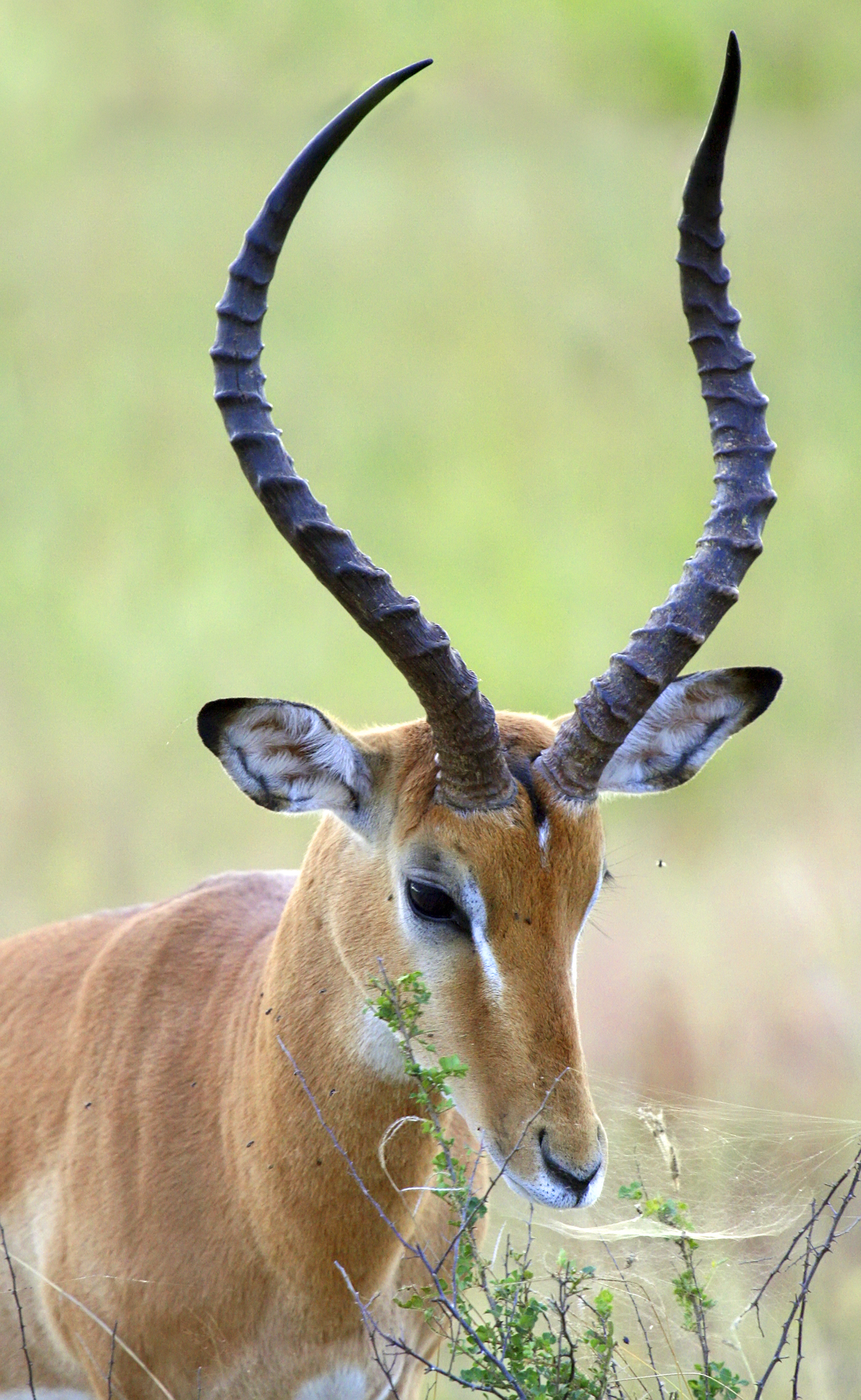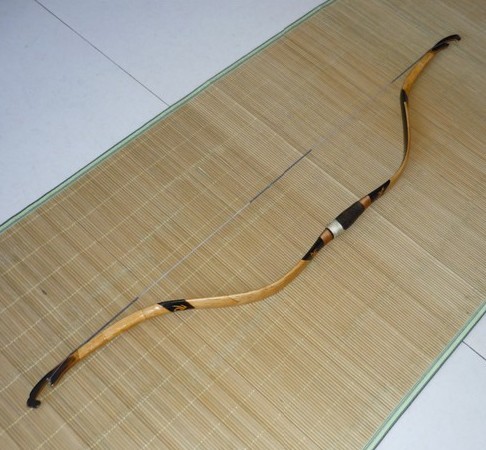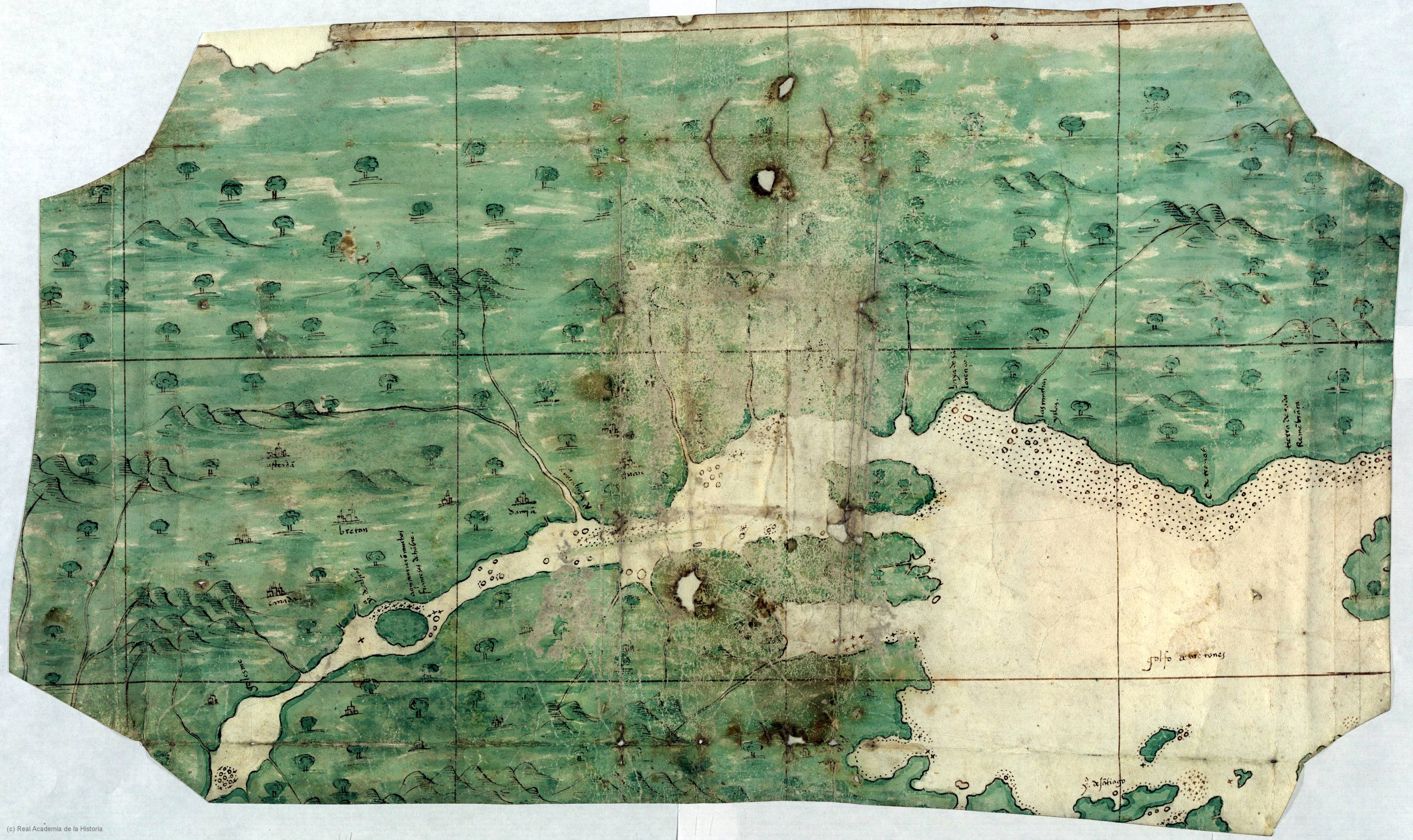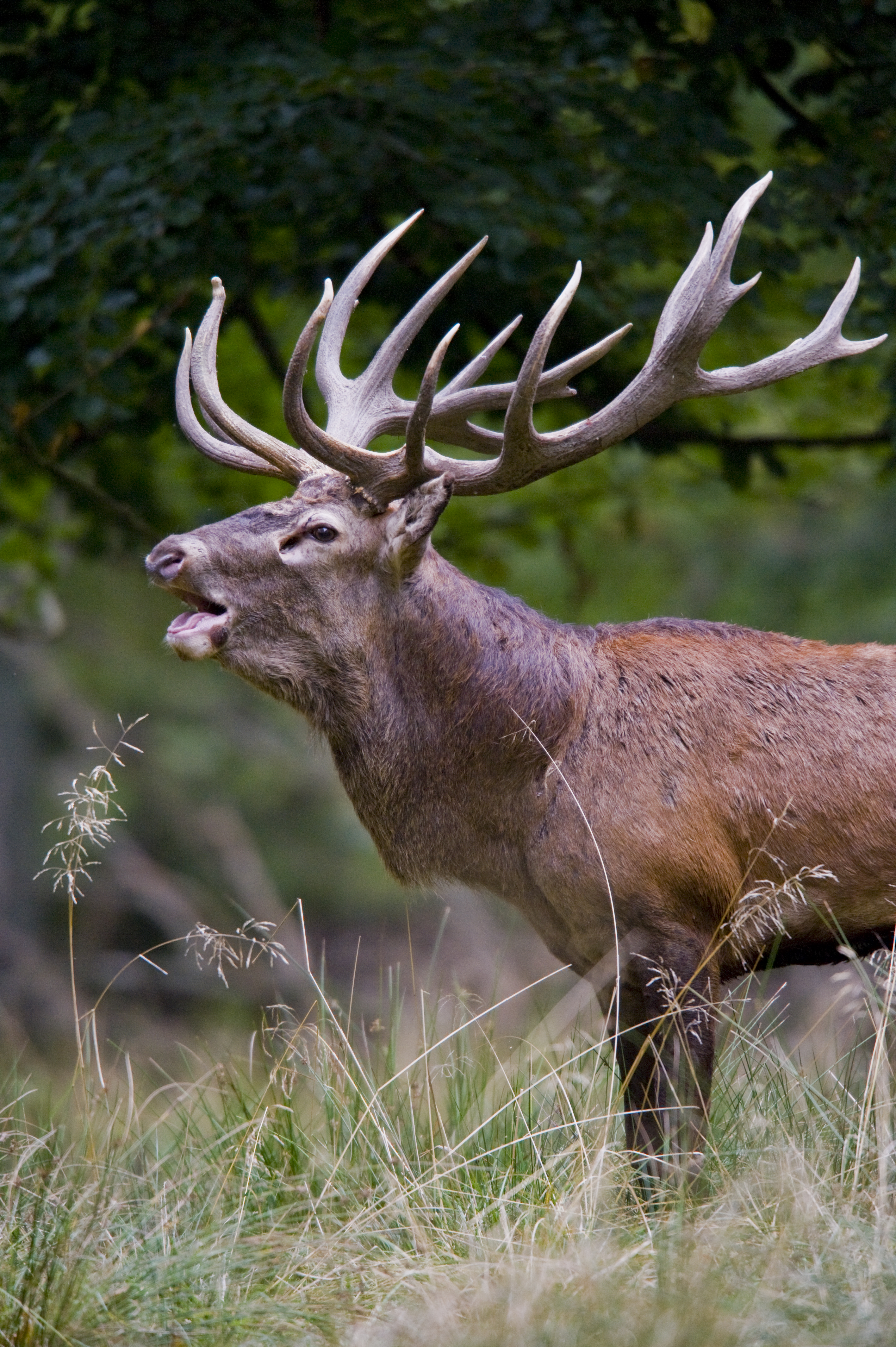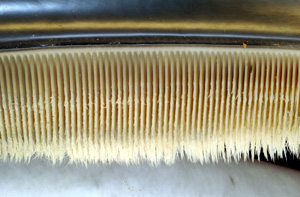|
Cable-backed Bow
A cable-backed bow is a bow reinforced with a cable on the back. The cable is made from either animal, vegetable or synthetic fibers and is tightened to increase the strength of the bow. A cable will relieve tension stress from the back of the bow by raising its neutral plane: the border between the back of the bow that stretches and the belly of the bow that compresses when bent. A good cable-backed bow can thus be made of poor-quality wood, weak in tension. The material, the diameter, the distance from the back of the wooden element, and the level of stress (tightness) of the cable determines how much it relieves tension stress from the wooden element of the bow and increases the power of the shot. The Inuit of the Arctic used sinew cables on their short bows of driftwood, baleen, horn or antler to make them unlikely to break in tension, and to increase their power. The cables are attached to the bow at several points on each limb with a series of half-hitches and then tigh ... [...More Info...] [...Related Items...] OR: [Wikipedia] [Google] [Baidu] |
Cable Bow
Cable may refer to: Mechanical * Nautical cable, an assembly of three or more ropes woven against the weave of the ropes, rendering it virtually waterproof * Wire rope, a type of rope that consists of several strands of metal wire laid into a helix ** Arresting cable, part of a system used to rapidly decelerate an aircraft as it lands ** Bowden cable, a mechanical cable for transmitting forces * Rope generally, especially a thick, heavy ("cable laid") variety Transmission * Electrical cable, an assembly of one or more wires which may be insulated, used for transmission of electrical power or signals ** Coaxial cable, an electrical cable comprising an inner conductor surrounded by a flexible, tubular insulating layer, coated or surrounded by a tubular conducting shield ** Power cable, a cable used to transmit electrical power ** Submarine communications cable, a cable laid on the sea bed to carry telecommunication signals between land-based stations * Fiber-optic cable, a cable co ... [...More Info...] [...Related Items...] OR: [Wikipedia] [Google] [Baidu] |
Horn (anatomy)
A horn is a permanent pointed projection on the head of various animals that consists of a covering of keratin and other proteins surrounding a core of live bone. Horns are distinct from antlers, which are not permanent. In mammals, true horns are found mainly among the ruminant artiodactyls, in the families Antilocapridae ( pronghorn) and Bovidae ( cattle, goats, antelope etc.). Cattle horns arise from subcutaneous connective tissue (under the scalp) and later fuse to the underlying frontal bone. One pair of horns is usual; however, two or more pairs occur in a few wild species and in some domesticated breeds of sheep. Polycerate (multi-horned) sheep breeds include the Hebridean, Icelandic, Jacob, Manx Loaghtan, and the Navajo-Churro. Horns usually have a curved or spiral shape, often with ridges or fluting. In many species, only males have horns. Horns start to grow soon after birth and continue to grow throughout the life of the animal (except in pronghorns, whi ... [...More Info...] [...Related Items...] OR: [Wikipedia] [Google] [Baidu] |
Composite Bow
A composite bow is a traditional bow made from horn, wood, and sinew laminated together, a form of laminated bow. The horn is on the belly, facing the archer, and sinew on the outer side of a wooden core. When the bow is drawn, the sinew (stretched on the outside) and horn (compressed on the inside) store more energy than wood for the same length of bow. The strength can be made similar to that of all-wood "self" bows, with similar draw-length and therefore a similar amount of energy delivered to the arrow from a much shorter bow. However, making a composite bow requires more varieties of material than a self bow, its construction takes much more time, and the finished bow is more sensitive to moisture. Archaeological finds and art indicate composite bows have existed since the second millennium BCE, but their history is not well recorded, being developed by cultures without a written tradition. They originated among Asiatic pastoralists who used them as daily necessities, ... [...More Info...] [...Related Items...] OR: [Wikipedia] [Google] [Baidu] |
Longbow
A longbow is a type of tall bow that makes a fairly long draw possible. Longbows for hunting and warfare have been made from many different woods in many cultures; in Europe they date from the Paleolithic era and, since the Bronze Age, were made mainly from yew, or from wych elm if yew was unavailable. The historical longbow was a self bow made of a single piece of wood, but modern longbows may also be made from modern materials or by gluing different timbers together. History Europe Prehistory A longbow was found in 1991 in the Ötztal Alps with a natural mummy known as Ötzi. His bow was made from yew and was long; the body has been dated to around 3300 BC. A slightly shorter bow comes from the Scottish parish of Tweedsmuir in a peat bog known as Rotten Bottom. The bow, made from yew, has been given a calibrated radiocarbon date of 4040 BC to 3640 BC. Another bow made from yew, found within some peat in Somerset, England has been dated to 2700–2600 BC. Forty longbo ... [...More Info...] [...Related Items...] OR: [Wikipedia] [Google] [Baidu] |
Flatbow
A flatbow is a bow with non- recurved, flat, relatively wide limbs that are approximately rectangular in cross-section. Because the limbs are relatively wide, flatbows will usually narrow and become deeper at the handle, with a rounded, non-bending handle for easier grip. This design differs from that of a longbow, which has rounded limbs that are circular or D-shaped in cross-section, and is usually widest at the handle. A flatbow can be just as long as a longbow, but can also be very short. Typical lengths would be for a flatbow, for an English longbow, and for a warbow-weight English longbow; but these styles may easily overlap each other. Traditional flatbows are usually wooden self bows (bows made of one solid piece of wood), though laminated and composite flatbows have been made in ancient and modern times. Modern flatbows commonly use fiberglass. Advantages of a rectangular cross-section The flatbow is a superior bow design for almost all materials because the str ... [...More Info...] [...Related Items...] OR: [Wikipedia] [Google] [Baidu] |
Wabenaki
The Wabanaki Confederacy (''Wabenaki, Wobanaki'', translated to "People of the Dawn" or "Easterner"; also: Wabanakia, "Dawnland") is a North American First Nations and Native American confederation of five principal Eastern Algonquian nations: the Abenaki, Mi'kmaq, Wolastoqiyik, Passamaquoddy (''Peskotomahkati'') and Penobscot. There were more tribes, along with many bands, that were once part of the Confederation. Native tribes such as the Nanrantsouak, Alemousiski, Pennacook, Sokoki, and Canibas, through massacres, tribal consolidation, and ethnic label shifting were absorbed into the five larger national identities. Members of the Wabanaki Confederacy, the Wabanakiyak, are located in and named for the area which they call Wabanaki ("Dawnland"), roughly the area that became the French colony of Acadia. The territory boundaries encompass present-day Maine, New Hampshire, and Vermont, in the United States, and New Brunswick, mainland Nova Scotia, Cape Breton Island, Prince ... [...More Info...] [...Related Items...] OR: [Wikipedia] [Google] [Baidu] |
Penobscot People
The Penobscot (Abenaki language, Abenaki: ''Pαnawάhpskewi'') are an Indigenous people in North America from the Indigenous peoples of the Northeastern Woodlands, Northeastern Woodlands region. They are organized as a List of federally recognized tribes, federally recognized tribe in Maine and as a First Nations in Canada, First Nations band government in the Atlantic Canada, Atlantic provinces and Quebec. The ''Penobscot Nation'', formerly known as the ''Penobscot Tribe of Maine,'' is the federally recognized Tribe (Native American), tribe of Penobscot in the United States."Tribal Directory" ''National Congress of American Indians''. Retrieved 30 August 2012. They are part of the Wabanaki Confederacy, along with the Abenaki, Passamaquoddy, Wolastoqiyik, and Miꞌkmaq nations, all of whom historically spoke Algonquian languages. Th ... [...More Info...] [...Related Items...] OR: [Wikipedia] [Google] [Baidu] |
Antler
Antlers are extensions of an animal's skull found in members of the Cervidae (deer) Family (biology), family. Antlers are a single structure composed of bone, cartilage, fibrous tissue, skin, nerves, and blood vessels. They are generally found only on males, with the exception of Reindeer, reindeer/caribou. Antlers are Moulting, shed and regrown each year and function primarily as objects of sexual attraction and as Weapon (biology), weapons. Etymology Antler comes from the Old French ''antoillier ''(see present French : "Andouiller", from'' ant-, ''meaning before,'' oeil, ''meaning eye and'' -ier'', a suffix indicating an action or state of being) possibly from some form of an unattested Latin word ''*anteocularis'', "before the eye" (and applied to the word for "branch" or "horn (anatomy), horn"). Structure and development Antlers are unique to cervids. The ancestors of deer had tusks (long upper canine tooth, canine teeth). In most species, antlers appear to replace t ... [...More Info...] [...Related Items...] OR: [Wikipedia] [Google] [Baidu] |
Baleen
Baleen is a filter feeder, filter-feeding system inside the mouths of baleen whales. To use baleen, the whale first opens its mouth underwater to take in water. The whale then pushes the water out, and animals such as krill are filtered by the baleen and remain as a food source for the whale. Baleen is similar to bristles and consists of keratin, the same substance found in human fingernails, skin and hair. Baleen is a skin derivative. Some whales, such as the bowhead whale, have baleen of differing lengths. Other whales, such as the gray whale, only use one side of their baleen. These baleen bristles are arranged in plates across the upper jaw of whales. Depending on the species, a baleen plate can be long, and weigh up to . Its hairy fringes are called baleen hair or whalebone hair. They are also called baleen bristles, which in sei whales are highly calcified, with calcification functioning to increase their stiffness. Baleen plates are broader at the gumline (base). The p ... [...More Info...] [...Related Items...] OR: [Wikipedia] [Google] [Baidu] |
Driftwood
Driftwood is a wood that has been washed onto a shore or beach of a sea, lake, or river by the action of winds, tides or waves. It is part of beach wrack. In some waterfront areas, driftwood is a major nuisance. However, the driftwood provides shelter and food for birds, fish and other aquatic species as it floats in the ocean. Gribbles, shipworms and bacteria decompose the wood and gradually turn it into nutrients that are reintroduced to the food web. Sometimes, the partially decomposed wood washes ashore, where it also shelters birds, plants, and other species. Driftwood can become the foundation for sand dunes. Most driftwood is the remains of trees, in whole or part, that have been washed into the ocean, due to flooding, high winds, or other natural occurrences, or as the result of logging. There is also a subset of driftwood known as drift lumber. Drift lumber includes the remains of man-made wooden objects, such as buildings and their contents washed into the sea duri ... [...More Info...] [...Related Items...] OR: [Wikipedia] [Google] [Baidu] |
Sinew
A tendon or sinew is a tough band of dense fibrous connective tissue that connects muscle to bone. It sends the mechanical forces of muscle contraction to the skeletal system, while withstanding tension. Tendons, like ligaments, are made of collagen. The difference is that ligaments connect bone to bone, while tendons connect muscle to bone. There are about 4,000 tendons in the adult human body. Structure A tendon is made of dense regular connective tissue, whose main cellular components are special fibroblasts called tendon cells (tenocytes). Tendon cells synthesize the tendon's extracellular matrix, which abounds with densely-packed collagen fibers. The collagen fibers run parallel to each other and are grouped into fascicles. Each fascicle is bound by an endotendineum, which is a delicate loose connective tissue containing thin collagen fibrils and elastic fibers. A set of fascicles is bound by an epitenon, which is a sheath of dense irregular connective tissue. ... [...More Info...] [...Related Items...] OR: [Wikipedia] [Google] [Baidu] |
